There were 25 posts tagged: Sennheiser
Do I Need a Remote Answer Device When I Buy My Wireless Headset?
September 9th, 2014 • 0 Comments
The wireless headset is a great tool to increase productivity and worker satisfaction. The decrease in neck, back, and shoulder pain and strain has been proven in several studies. On its own, a wireless headset is a great thing. With the addition of a remote answer device you are able to achieve true wireless freedom by being able to answer and end calls up to 450 feet away from your desk!
Remote answer devices come in two different styles: Remote Handset Lifter and Electronic Hook Switch Cable.
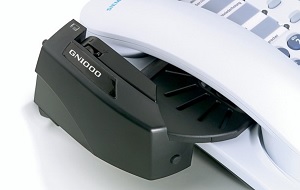 adhesive mounting strips. It will then connect to the headset base with an included cable.
adhesive mounting strips. It will then connect to the headset base with an included cable.
When the phone rings, the RHL sends a tone into your wireless headset to alert you of the incoming call. Simply press the answer/end button on the wireless headset and you’re connected to the caller. When you answer the call, the RHL lifts the handset up; when you end the call, the RHL lowers the handset into the cradle to disconnect the call.
RHLs are compatible with the majority of office telephones.
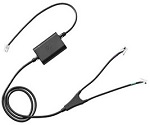 that with an EHS cable in place, the phone’s handset does not physically move up or down.
There are a myriad of EHS cables, and the one that’s right for you depends upon your office phone’s make and model.
that with an EHS cable in place, the phone’s handset does not physically move up or down.
There are a myriad of EHS cables, and the one that’s right for you depends upon your office phone’s make and model.
The EHS cable passes predefined signaling to either answer or end the call.
Jabra Compatibility Guide
Plantronics Compatibility Guide
Sennheiser Compatibility Guide
VXi Compatibility Guide
If you’re curious about a wireless headset and the true freedom you can experience at work, give us a call at 1-866-998-9991. To read more about why we love wireless headsets, read our blog post here: Why Avcomm Loves Wireless Headsets (And You Should Too!).
Remote answer devices come in two different styles: Remote Handset Lifter and Electronic Hook Switch Cable.
What is a Remote Handset Lifter?
A remote handset lifter (RHL) attaches to the top of the phone, underneath the handset, with adhesive mounting strips. It will then connect to the headset base with an included cable.
adhesive mounting strips. It will then connect to the headset base with an included cable.When the phone rings, the RHL sends a tone into your wireless headset to alert you of the incoming call. Simply press the answer/end button on the wireless headset and you’re connected to the caller. When you answer the call, the RHL lifts the handset up; when you end the call, the RHL lowers the handset into the cradle to disconnect the call.
RHLs are compatible with the majority of office telephones.
What is an EHS cable?
An electronic hookswitch cable attaches to your phone and headset base, and electronically allows you to answers and ends calls away from the desk. It’s important to note that with an EHS cable in place, the phone’s handset does not physically move up or down.
There are a myriad of EHS cables, and the one that’s right for you depends upon your office phone’s make and model.
that with an EHS cable in place, the phone’s handset does not physically move up or down.
There are a myriad of EHS cables, and the one that’s right for you depends upon your office phone’s make and model.
How do remote answer devices work?
Typically, handset lifters respond to sounds within a certain frequency range. The Sennheiser HSL10 has a unique ring tone detection via a high quality microphone. Jabra’s GN1000 RHL (pictured) senses the magnetic field the speaker generates when your phone rings, which means it’s virtually foolproof.The EHS cable passes predefined signaling to either answer or end the call.
Phone Compatibility
Each of the manufacturers offers a Headset Compatibility Guide on their web site to help determine whether you will need an EHS cable or a remote handset lifter.Jabra Compatibility Guide
Plantronics Compatibility Guide
Sennheiser Compatibility Guide
VXi Compatibility Guide
If you’re curious about a wireless headset and the true freedom you can experience at work, give us a call at 1-866-998-9991. To read more about why we love wireless headsets, read our blog post here: Why Avcomm Loves Wireless Headsets (And You Should Too!).
Show Me the Money
August 29th, 2014 • 0 Comments
The movie “Jerry Maguire” features a great scene with Cuba Gooding, Jr., as an aging professional football player telling his agent Jerry Maguire that he needs to “show me the money” – Jerry needs to negotiate a high-dollar contract for his client.
This phrase is easily applicable in industry and government, where shareholders, stakeholders and more are scrutinizing the bottom line. ROI (return on investment) is a much discussed term that attempts to determine the value of something and its impact on the company’s overall financial health.
Scaled-down budgets and budget cuts are forcing many to stretch their limited resources. It can be a temptation when looking at a reduced budget to quickly make decisions based upon price alone. You have X amount of dollars, and so you look for a low price, giving you (theoretically) more product for the money. Unfortunately, you get what you pay for.
A high quality headset may have a higher price tag, but over the long run, offers a better value and costs less – equaling happier customers and employees. How?
Source: Choosing the best direct connect headset solution for your contact center. Plantronics whitepaper. 1/23/08.
This phrase is easily applicable in industry and government, where shareholders, stakeholders and more are scrutinizing the bottom line. ROI (return on investment) is a much discussed term that attempts to determine the value of something and its impact on the company’s overall financial health.
Scaled-down budgets and budget cuts are forcing many to stretch their limited resources. It can be a temptation when looking at a reduced budget to quickly make decisions based upon price alone. You have X amount of dollars, and so you look for a low price, giving you (theoretically) more product for the money. Unfortunately, you get what you pay for.
A high quality headset may have a higher price tag, but over the long run, offers a better value and costs less – equaling happier customers and employees. How?
- Durable construction – Corded headsets can clutter a workstation. Chairs roll over the cords on the floor, feet can get tangled in them, and the general use of corded headsets can cause cords to break, snag, and fall off. Headsets offered by Avcomm Solutions have been tested by the manufacturers for user-proof adoption.
The recent trend in headset manufacturing has been the inclusion of Kevlar cords. We know that Kevlar bullet-proof vests in the law enforcement community stop bullets, and the Kevlar reinforced headset cords add a layer of protection to the cords, so they aren’t easily broken down.
High quality, heavy duty materials – plus design features that minimize the damage that can come from repetitive and sometimes hard use – will keep your agents on the phones. - Reliability – With call centers running sometimes continuous 24-hour shifts, appropriate agent coverage is a necessity. Can you rely on your headsets to work when your agents need them? Increase first call resolution, improve engagement, and reduce hold times with a reliable headset.
- Comfort – The fit and feel of a headset can contribute to your agent’s job satisfaction. Heavy phone users – those on the phone for the majority of their workday – will appreciate a comfortable headset that doesn’t pinch or fall off their head and ears. A happy agent makes for a happy customer!
- Excellent sound quality – The ability to hear and really listen to the person on the other end of the call is critical. Cisco has identified and categorized voice quality problems including echo, tunnel, soft, loud, or tinny voice, and absolute silence, as just some of the voice quality problems during phone calls: Recognizing and Categorizing Symptoms of Voice Quality Problems.
Companies that specialize in designing headsets for call-centric environments have value-added features. Audio technologies and hearing protections such as SafeTone (Jabra), ActiveGard (Sennheiser) and Sound Guard (Plantronics) ensure the safety of headset wearers. To read more about these technologies, check out our blog post: Say What? The research and development necessary to produce the best headsets for call-centric environments is a continuous evolution of excellence for our headset manufacturers.
- Noise cancelling microphones – If you are in a busy, crowded or noisy office environment, noise-cancelling microphones are a must and definitely worth the added cost. Colleagues and other background noises (copy machines included) are filtered out and therefore not transmitted to your caller through the microphone. Companies dealing with highly sensitive data, including credit card information, will provide peace of mind to callers who won’t hear other customers’ conversations in the background of their agent’s microphone. For a more detailed listing of microphone types, read our blog post.
- Warranty replacement – A warranty replacement policy is another standard for high quality headsets. Sometimes, due to carelessness, or other issues, headsets can break or fail. Our manufacturers offer a 2-year, and sometimes 3-year warranty replacement, on their corded headsets. You won’t be purchasing replacement headsets regularly with this safeguard in place!
Source: Choosing the best direct connect headset solution for your contact center. Plantronics whitepaper. 1/23/08.
SP 20 Brings Sennheiser Sound Together With Conference Capabilities
August 6th, 2014 • 0 Comments
The Sennheiser brand has produced another award-winning product in the SP 20 Speakerphone, receiving both the 2014 iF Product Design and RedDot awards. Ease of use, quality craftsmanship and a discrete profile recommend the Sennheiser SP 20 ML for conference and huddle rooms, as well as individual use.
“Feedback from our strategic seeding and early market samples only further elevated our eagerness for the release of our new SP20 personal speakerphone product,” he reported.
The positive buzz surrounding the release of the SP series of speakerphones (which also includes the SP 10 models) caused early sell-outs and product shortages.
“Many times new product releases struggle to grab market interest early on, not the case with the Sennheiser SP series. Fortunately/unfortunately our SP series speakerphone garnered so much interest pre-release that we quickly sold through our initial expected stocking order and several very large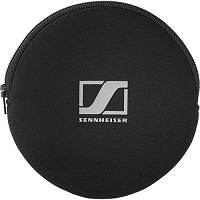 companies placed orders worldwide that quickly depleted our initial production stock,” he said.
companies placed orders worldwide that quickly depleted our initial production stock,” he said.
“The good news is production has been ramped up and stock is available. If you have not already experienced the premium audio performance of the Sennheiser Telephony, UC and Collaboration products we are confident the SP series of personal speakerphones will not disappoint.”
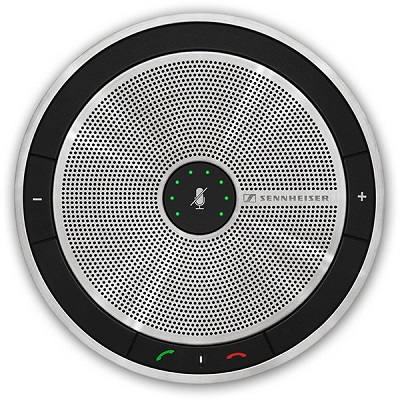 The SP 20 weighs in at a mere 7.35 ounces. The composite metal face and surrounding side lend a designer touch to the otherwise black plastic speakerphone. The mute button, indicated by a microphone with a slash through it, is in the middle of the speakerphone; surrounding the mute button are 8 LED lights; they indicate volume (in green); mute (red); and remaining battery power (blue). At the bottom of the device, red and green handset buttons answer and end calls. Volume buttons, - (decrease) and + (increase) are anchored to the left and right of the device.
The SP 20 weighs in at a mere 7.35 ounces. The composite metal face and surrounding side lend a designer touch to the otherwise black plastic speakerphone. The mute button, indicated by a microphone with a slash through it, is in the middle of the speakerphone; surrounding the mute button are 8 LED lights; they indicate volume (in green); mute (red); and remaining battery power (blue). At the bottom of the device, red and green handset buttons answer and end calls. Volume buttons, - (decrease) and + (increase) are anchored to the left and right of the device.
The USB and 3.5 mm cords wrap around the middle of the device and stay connected to the SP 20, so there’s no fear of loss. Connect either the USB cord to a PC/softphone, or the 3.5 mm cable to a mobile phone or tablet. When you’re not on a call, and the device is connected to your mobile phone or tablet, the mute button becomes an equalizer: simply press the mute button for 5 seconds, and you get the world-renowned Sennheiser sound quality to listen to your music. Charge via USB for up to 20 hours of talk time; when connected via USB, get unlimited talk time.
The simplicity of use does not translate into a simple device: The dual talk feature allows for natural conversation and echo cancelling removes sound reflections. You can merge your PC/softphone and mobile calls into one conference across the devices. The illustrated Quick Start Guide shows this functionality at a glance.
At an MSRP cost of $199.95, this speakerphone won’t break the bank. There are a variety of situations where the SP 20 would be the perfect product - personal offices, huddle rooms, conference rooms, and more - and with a two-year warranty, Sennheiser gives you peace of mind.
Do you have questions about how the SP 20 ML would work best for your office needs? Give us a call at 866-998-9991 and our team would be happy to assist you!
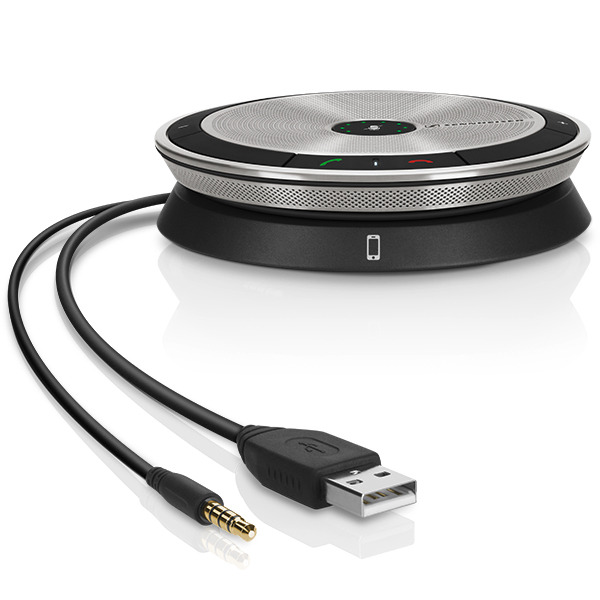
“Feedback from our strategic seeding and early market samples only further elevated our eagerness for the release of our new SP20 personal speakerphone product,” he reported.
The positive buzz surrounding the release of the SP series of speakerphones (which also includes the SP 10 models) caused early sell-outs and product shortages.
“Many times new product releases struggle to grab market interest early on, not the case with the Sennheiser SP series. Fortunately/unfortunately our SP series speakerphone garnered so much interest pre-release that we quickly sold through our initial expected stocking order and several very large
 companies placed orders worldwide that quickly depleted our initial production stock,” he said.
companies placed orders worldwide that quickly depleted our initial production stock,” he said. “The good news is production has been ramped up and stock is available. If you have not already experienced the premium audio performance of the Sennheiser Telephony, UC and Collaboration products we are confident the SP series of personal speakerphones will not disappoint.”
Let’s meet the SP 20
When you open the SP 20 box, the speakerphone is zipped inside its convenient tailored neoprene carrying pouch – making this speakerphone easy to travel with. The SP 20 weighs in at a mere 7.35 ounces. The composite metal face and surrounding side lend a designer touch to the otherwise black plastic speakerphone. The mute button, indicated by a microphone with a slash through it, is in the middle of the speakerphone; surrounding the mute button are 8 LED lights; they indicate volume (in green); mute (red); and remaining battery power (blue). At the bottom of the device, red and green handset buttons answer and end calls. Volume buttons, - (decrease) and + (increase) are anchored to the left and right of the device.
The SP 20 weighs in at a mere 7.35 ounces. The composite metal face and surrounding side lend a designer touch to the otherwise black plastic speakerphone. The mute button, indicated by a microphone with a slash through it, is in the middle of the speakerphone; surrounding the mute button are 8 LED lights; they indicate volume (in green); mute (red); and remaining battery power (blue). At the bottom of the device, red and green handset buttons answer and end calls. Volume buttons, - (decrease) and + (increase) are anchored to the left and right of the device. The USB and 3.5 mm cords wrap around the middle of the device and stay connected to the SP 20, so there’s no fear of loss. Connect either the USB cord to a PC/softphone, or the 3.5 mm cable to a mobile phone or tablet. When you’re not on a call, and the device is connected to your mobile phone or tablet, the mute button becomes an equalizer: simply press the mute button for 5 seconds, and you get the world-renowned Sennheiser sound quality to listen to your music. Charge via USB for up to 20 hours of talk time; when connected via USB, get unlimited talk time.
The simplicity of use does not translate into a simple device: The dual talk feature allows for natural conversation and echo cancelling removes sound reflections. You can merge your PC/softphone and mobile calls into one conference across the devices. The illustrated Quick Start Guide shows this functionality at a glance.
At an MSRP cost of $199.95, this speakerphone won’t break the bank. There are a variety of situations where the SP 20 would be the perfect product - personal offices, huddle rooms, conference rooms, and more - and with a two-year warranty, Sennheiser gives you peace of mind.
Do you have questions about how the SP 20 ML would work best for your office needs? Give us a call at 866-998-9991 and our team would be happy to assist you!
Connecting with Microsoft Partners at WPC14
July 21st, 2014 • 0 Comments
We recently had the pleasure of attending the Microsoft Worldwide Partner Conference in Washington, D.C., last week. Our expectations were high, and we weren't disappointed. At 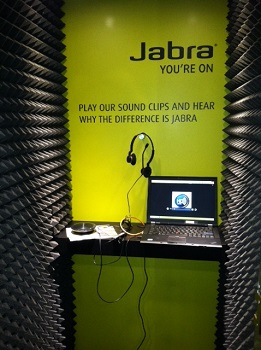 the Monday morning Vision Keynote address, Microsoft leaders articulated the organization's "clear and differentiated vision for the future in a mobile-first, cloud-first world."
the Monday morning Vision Keynote address, Microsoft leaders articulated the organization's "clear and differentiated vision for the future in a mobile-first, cloud-first world."
Enterprise solutions that are secure, functional and rich with features is what Microsoft brings to the table, and with new ways of offering their software, Microsoft continues to stay at the forefront of its class. The launch and success of Office 365, a cloud based subscription suite of office software that makes your business more productive with its Software as a Service (SaaS) approach. According to Microsoft, 60% of Fortune 500 companies have purchased Office 365 in the past year.
Throughout the Commons Expo, networking opportunities were plentiful. Signing up and scheduling meetings in the Connect Portal was another way to schedule networking opportunities. And after-hours parties, sponsored by corporations, was a more informal way to visit with potential business partners.
The headset manufacturers that Avcomm offers each had a presence at the event. Jabra's sound booth invited guests to hear the difference using either a Speak 510 speakerphone or the new BIZ 2300 series headset. Additional headset models were available to play with; Jabra lives by the motto "Devices Make Experiences" and that hands-on availability encouraged visitors to test a variety of devices. Tony Everson, Jabra's Director of Strategic Alliances - Microsoft, was enthusiastic about this year's WPC.
At the Sennheiser booth, the new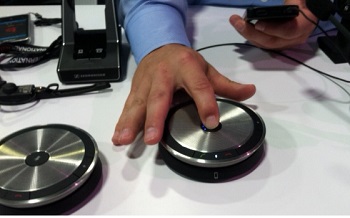 SP 10 and SP 20 speakerphones were prominently featured front and center. Plugging the SP 20 Microsoft Lync certified speakerphone into his cell phone, Area Sales Manager Jon Leighton (Telecom - Northeast) showed off the equalizer function of the device. The solid speakerphone, with stainless steel on its face, is a sleek device with powerful sound.
SP 10 and SP 20 speakerphones were prominently featured front and center. Plugging the SP 20 Microsoft Lync certified speakerphone into his cell phone, Area Sales Manager Jon Leighton (Telecom - Northeast) showed off the equalizer function of the device. The solid speakerphone, with stainless steel on its face, is a sleek device with powerful sound.
On Tuesday, Plantronics unveiled a new program at WPC called Plantronics Device-as-a-Service for SMB and mid-market customers to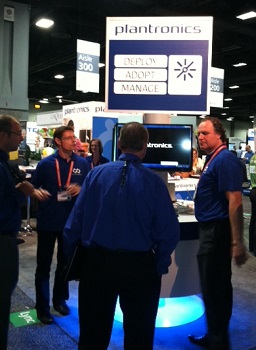 acquire Plantronics solutions along with cloud services. This makes it easy to acquire a complete solution, in a pay-as-you-go manner with 12-, 24-, and 36-month payment options. More information about the program here.
acquire Plantronics solutions along with cloud services. This makes it easy to acquire a complete solution, in a pay-as-you-go manner with 12-, 24-, and 36-month payment options. More information about the program here.
One of our favorite finds at WPC was the new Windows Apportals app. With this, we quickly created our very own Avcomm Solutions app! Microsoft says Windows Apportals "allows you to integrate your entire Line of Business (LOB) stack into a single, modern, touch-based experience. The concept behind Apportals is simple – introduce the same nested folder structure common in a desktop OS to the modern mobile OS."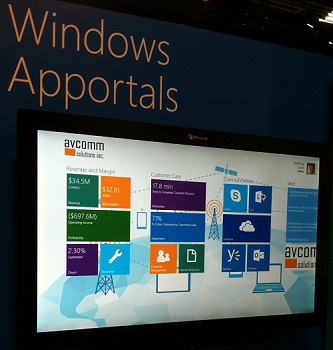 Users can set security levels to provide targeted information for your users.
Users can set security levels to provide targeted information for your users.
Next year, WPC will take place in Orlando, a tempting way to mix business along with a family vacation to see all of the sights Orlando offers!
Did you attend WPC in Washington, D.C.? What was the highlight of your experience? You can share your thoughts on the Comments tab at the top of this post.
 the Monday morning Vision Keynote address, Microsoft leaders articulated the organization's "clear and differentiated vision for the future in a mobile-first, cloud-first world."
the Monday morning Vision Keynote address, Microsoft leaders articulated the organization's "clear and differentiated vision for the future in a mobile-first, cloud-first world." Enterprise solutions that are secure, functional and rich with features is what Microsoft brings to the table, and with new ways of offering their software, Microsoft continues to stay at the forefront of its class. The launch and success of Office 365, a cloud based subscription suite of office software that makes your business more productive with its Software as a Service (SaaS) approach. According to Microsoft, 60% of Fortune 500 companies have purchased Office 365 in the past year.
Throughout the Commons Expo, networking opportunities were plentiful. Signing up and scheduling meetings in the Connect Portal was another way to schedule networking opportunities. And after-hours parties, sponsored by corporations, was a more informal way to visit with potential business partners.
The headset manufacturers that Avcomm offers each had a presence at the event. Jabra's sound booth invited guests to hear the difference using either a Speak 510 speakerphone or the new BIZ 2300 series headset. Additional headset models were available to play with; Jabra lives by the motto "Devices Make Experiences" and that hands-on availability encouraged visitors to test a variety of devices. Tony Everson, Jabra's Director of Strategic Alliances - Microsoft, was enthusiastic about this year's WPC.
At the Sennheiser booth, the new
 SP 10 and SP 20 speakerphones were prominently featured front and center. Plugging the SP 20 Microsoft Lync certified speakerphone into his cell phone, Area Sales Manager Jon Leighton (Telecom - Northeast) showed off the equalizer function of the device. The solid speakerphone, with stainless steel on its face, is a sleek device with powerful sound.
SP 10 and SP 20 speakerphones were prominently featured front and center. Plugging the SP 20 Microsoft Lync certified speakerphone into his cell phone, Area Sales Manager Jon Leighton (Telecom - Northeast) showed off the equalizer function of the device. The solid speakerphone, with stainless steel on its face, is a sleek device with powerful sound.On Tuesday, Plantronics unveiled a new program at WPC called Plantronics Device-as-a-Service for SMB and mid-market customers to
 acquire Plantronics solutions along with cloud services. This makes it easy to acquire a complete solution, in a pay-as-you-go manner with 12-, 24-, and 36-month payment options. More information about the program here.
acquire Plantronics solutions along with cloud services. This makes it easy to acquire a complete solution, in a pay-as-you-go manner with 12-, 24-, and 36-month payment options. More information about the program here.One of our favorite finds at WPC was the new Windows Apportals app. With this, we quickly created our very own Avcomm Solutions app! Microsoft says Windows Apportals "allows you to integrate your entire Line of Business (LOB) stack into a single, modern, touch-based experience. The concept behind Apportals is simple – introduce the same nested folder structure common in a desktop OS to the modern mobile OS."
 Users can set security levels to provide targeted information for your users.
Users can set security levels to provide targeted information for your users. Next year, WPC will take place in Orlando, a tempting way to mix business along with a family vacation to see all of the sights Orlando offers!
Did you attend WPC in Washington, D.C.? What was the highlight of your experience? You can share your thoughts on the Comments tab at the top of this post.
TAGS
The 3 Keys to Controlling Background Noise in your Contact Center
October 21st, 2013 • 0 Comments
.jpg) The professional contact center defines a customer's perception of your company and is a key component to company success. Your agents are the first, and sometimes only,
contact your customers have with your business! There is no greater frustration for a customer than calling a business with a quick question or complaint – only to find
the contact center agent is unknowledgeable, unhelpful or difficult to understand. If the agent works in a noisy center and the customer can hear conversations in the
background, the impression of an amateur organization is made.
The professional contact center defines a customer's perception of your company and is a key component to company success. Your agents are the first, and sometimes only,
contact your customers have with your business! There is no greater frustration for a customer than calling a business with a quick question or complaint – only to find
the contact center agent is unknowledgeable, unhelpful or difficult to understand. If the agent works in a noisy center and the customer can hear conversations in the
background, the impression of an amateur organization is made.
You can virtually eliminate background noise in your contact center with the 3 E's: Environment, Expectation and Equipment.
 Josh Reeves,
CEO of Entero Solutions (a BPO consulting firm), has worked in the contact center industry since 1999.
He shared some valuable insights into structuring a professional (and quiet) contact center.
Josh Reeves,
CEO of Entero Solutions (a BPO consulting firm), has worked in the contact center industry since 1999.
He shared some valuable insights into structuring a professional (and quiet) contact center.

- Environment
Make sure there is plenty of space between agents! Reeves suggests that alternating agents by their tasks helps: alternate voice products, live chat, e-mail callbacks, and order entry, so that not all agents who work primarily on the phone are grouped together. When building the center, think about noise-controlling features from top to bottom: egg carton acoustic foam pieces in higher ceilings, as well as sound absorbing ceiling tiles. On the walls, designs can be created with sound absorbing fabric. Cubicle partitions can be made with those same fabrics and partitions can be built taller so agents aren't directly looking at each other. For the floors, carpet works best to trap sound.
- Expectation
Maintaining near-silence on the call floor, outside of calls, is important. If you think of this as "library quiet" you've got the right idea! Employees should have the expectation that chatting with each other between calls is kept to a minimum. Visitors to the contact center should be made aware of the quiet policy, and signs posted throughout the center are effective reminders of being mindful of noise levels.
Customers, too, have expectations. They trust your company with their personal and confidential information and presume that they will speak one-on-one with your company's representative. This trust can soon be lost if the customer is able to hear other conversations in the background. Reps who speak over your customers because they are unable to hear the phone conversation, also lose the trust of your customers.
- Equipment
Reeves advises centers to "give agents the best equipment possible to get the results you're looking for." Two-ear (duo) headsets with noise-cancelling microphones are the best choice, says Reeves: "They (agents) can hear really well, and in turn, not have to speak as loud. They can maintain focus on the customer they are working with."
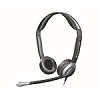 Additionally, ultra noise-cancelling offers enhanced noise-cancelling properties which carry your employees' voices so they can speak at normal, professional levels and still
be heard by your customers. These microphones are best for the loudest contact centers, particularly outbound centers. The enhanced noise-cancelling microphones keep the
background noises from disrupting conversations – essential to maintaining a professional contact center image.
Additionally, ultra noise-cancelling offers enhanced noise-cancelling properties which carry your employees' voices so they can speak at normal, professional levels and still
be heard by your customers. These microphones are best for the loudest contact centers, particularly outbound centers. The enhanced noise-cancelling microphones keep the
background noises from disrupting conversations – essential to maintaining a professional contact center image.
Sennheiser's exclusive noise reduction technology, Adaptive Intelligence™, uses a complex digital signal processor to eliminate incoming and outgoing noise automatically, all while preserving the speech of the using parties. When moving from one dynamic noise environment to the other, the headset automatically compensates according to the unique environment and the users' preferences.
 Amplifiers play a role as well. These sound management devices
detect when the agent is not talking, and automatically lowers the microphone signal reducing outgoing background noise. The caller experiences a quiet pause rather than annoying
background chatter! An amplifier quiets the line from the noises, crackles and background hisses, and offers hearing protection from the sometimes loud sound spikes that occur
during calls. For less than $100, amplifiers make an inexpensive addition to the total sound package.
Amplifiers play a role as well. These sound management devices
detect when the agent is not talking, and automatically lowers the microphone signal reducing outgoing background noise. The caller experiences a quiet pause rather than annoying
background chatter! An amplifier quiets the line from the noises, crackles and background hisses, and offers hearing protection from the sometimes loud sound spikes that occur
during calls. For less than $100, amplifiers make an inexpensive addition to the total sound package.
Reeves also suggests checking into warranties for the headsets. "I think it's important when getting your headsets that they have a good warranty because they're used, in some cases, 24 hours a day," says Reeves. Jabra, Plantronics and Sennheiser all offer at least a 2-year warranty for their corded headsets.
When all three keys have been effectively implemented – Environment, Expectation and Equipment – a quiet, professional contact center is the result. Your customer, and your employees, deserve nothing less than the best!


